

MacBeth's
 Opinion
Opinion
...home of text-free learning in association with
and
(Shopping at our affiliates helps pay for website...but no pressure!)
More articles on this web-site:
Charlotte Mason's Cure for Tired Text-taught Tots
Advent Projects: Candles and Calendars (with music suggestions)
Amazon Listmania:
Earth Science, the study of the earth, is a high school introduction to geology. It is usually the first of the sciences taught in high school, though some high school programs omit it all together. While I avoid any traditional geology text books, I believe that plenty of reading, accompanied by excellent field work, can provide any student with enough background to excel in continued study of geology.
Listed below are some living books on geological topics, and some basic books which can act as a spine for the study. A review book, like Barron's Let's Review Earth Science, can provide the student with alternative explanations, exercises, and final exams at a reasonable price.
For field work, you're in luck! You live on the Earth! Finding a place to observe geology, the study of the Earth, should be easy! The tough thing is recognizing geology under a city or suburban landscape. The roadside geology books (see below) are a great way to see what your state has to offer geologically without going to far, if you can be satisfied with the geology that surrounds you. Here on Long Island the only rocks are glacial erratics (the rocks scraped off the mountains to the north and carried here during the ice age). Sure, I'd love to study volcanism, but post-glacial geology is local, so it has become my specialty. Maybe your area has volcanoes, or a glacier, or caves, or beaches, or petrified forests, or badlands, or impact craters, or geysers...whatever is there, work with it. Each environment has geologically interesting features. Find out more about your region at the US Geological Survey site.
If you are interested in making a collection, make sure you have permission of the land owner. Use a rock hammer to take small samples of larger rocks so your collection fits into your home or garage.
Read free online booklets from the USGS:
Volcanoes of the United States
Field Work
Click on these thumbnails to see photos of a few of our geological adventures:
See Photos of our diamond mining trip!
Get in the car and learn geology! This acclaimed series takes advantage of that great marvel of modern road-building--the road cut. Blasting for highways has exposed rock layers and other interesting geological features.
Roadside Geology Series:
Baja California (includes biology!)
Can't get there from here? Watch a videos from the USGS:
Living Rock (the "Intro to Earth Science" video most students see)
Geology (fyi, most geology books are written from an "old earth" perspective)
The Seashell on the Mountain is the story of Bl. Niels Steno. This is a secular account, but the story is good!
The Practical Geologist is an excellent book for beginners, with all you need to know about rock formation and identification. Ideas, demonstrations, and more!
The Control of Nature and Annals of the Former World
by John McPhee (McPhee is wonderful, expressing scientific thought in layman's terms)Volcanoes in America's National Parks by Barbara and Robert Decker (travel and learn!)
Earthshaking Science: What we know and What we don't Know about Earthquakes by Susan Hough
Longitude : The True Story of a Lone Genius Who Solved the Greatest Scientific Problem of His Time by Dava Sobel
Exploring the Earth With John Wesley Powell by Michael Elsohn Ross (quick, good biography for young children)
The Exploration of the Colorado River and Its Canyons by John Wesley Powell
Beneath Our Feet : The Rocks of Planet Earth by R. H. Vernon
Melting the Earth : The History of Ideas on Volcanic Eruptions by Haraldur Sigurdsson
After the Ice Age : The Return of Life to Glaciated North America by E. C. Pielou
The Secret Life of Dust by Hannah Holmes (It's everywhere!)
Volcano Cowboys by Dick Thompson (brave guys...)
Earth in Turmoil : Earthquakes, Volcanoes, and Their Impact on Humankind by Kerry Sieh
Weather
for environmental geologists and meteorologists:
The Invention of Clouds by Richard Hamblyn is a history of the names of cloud formations. A beautiful and informative book.
A Field Guide to the Atmosphere (Peterson Guide)
The Snowflake Man : A Biography of Wilson A. Bentley by Duncan C. Blanchard (remember reading Snowflake Bentley with your little ones? High-schoolers can revisit Bentley in this biography)
Tying Down the Wind by Eric Pinder is a delightful romp with a meteorologist on Mt. Washington, and despite the reviewers' grumbles, it's a good read (or listen, as it is available from Audible, too). Brrr!
Clouds in a Glass of Beer fun with atmospheric physics...really, I did say "fun."
Laboratory Manuals and Equipment
Prospector's gold pans, rock hammers, field bags (these are great!), goggles and more, available from Amazon, or from the following science equipment supply companies, which also carry rock samples: